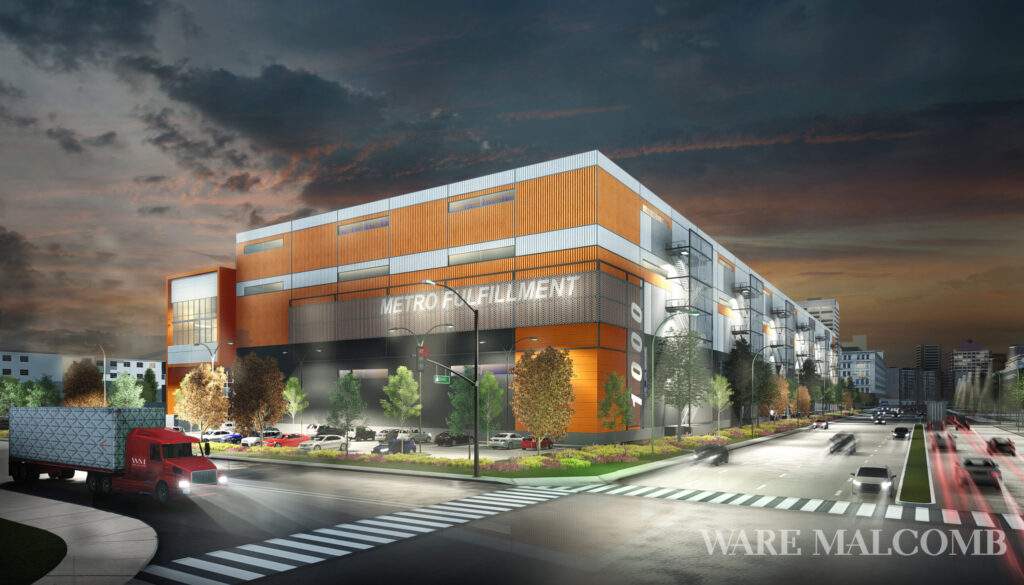Why the Future of Warehousing is Up, Not Out
Recently, I had the opportunity to catch up with Jay Todisco, President of Ware Malcomb to talk about the current state of warehousing and distribution. Ware Malcomb has been providing Architectural Design Services to developers and end users for over 45 years with a specific focus on the design of industrial buildings.
Historically, commercial real estate has been a late adopter of technology, but that is no longer the case. According to Jay, “The future is here with the adoption of automation, robotics, and now artificial intelligence. The steady acceptance and explosion of e-commerce because of Covid-19 has further challenged architects and engineers to push the boundaries of traditional rentable space beyond where just a few years ago, it would have been unheard of. The world has changed quickly.”
Accelerated delivery of goods within the same or a 2-day timeframe has become the industry norm and requires one key logistical challenge for companies: location. To make this possible, the product must be close enough to the consumer.
Increasing limits in urban space makes finding an optimal location a challenge, especially for substantial warehouse footprints. Limited supply makes existing space more valuable. Further exacerbating the pressure, vacant land to construct new warehouses competes directly against infill demand for mixed-use, office, multifamily and residential development.
Multistory warehousing is clearly becoming the answer for urban industrial. “We all know about the lack of land, high costs in dense population centers and the demand to service last mile consumer expectations becomes expediential. The solution is to build vertically. We have designed and engineered fully functional multistory warehouses using fundamentals accepted by forward looking, opportunistic capital markets.” What was once an idea just 3 short years ago, before the term “last mile” was part of the vernacular “…has been validated by the fact that these buildings are now being built on spec by major national developers, and leased by major e-commerce users over and over.”
These highly functioning warehouses are already common in the population-dense countries in Asia where space commands premium rates. Prologis was the first company in the United States to construct a new generation multistory warehouse in downtown Seattle. Completed back in 2018, the three-story structure reimagined what this type of space could look like for compacted, infill markets.
Seattle is one population cluster already benefiting from this specialized warehousing solution. More will follow. Skyrocketing land prices in Los Angeles, New York, and San Francisco to name only a few make these cities prime candidates with a number of multistory buildings already in a variety of planning phases.
Todisco added, “Developers and occupiers alike are looking to enhance capital deployment decisions related to industrial space. Everything is changing from increasing site coverage, to efficiencies in parking – truly maximizing every inch of space.”
However, building tomorrow’s modernized facility isn’t cheap. These new structures require appropriate power, clearance height, parking and different engineering standards than a single-floor warehouse and must withstand the increased load. Most existing warehouse buildings are incapable of retrofitting into a multistory structure. “The intersection and pressure from capital markets on industrial real estate continues to transform the design, particularly on build to suit projects. Building shells must be more mainstream to insure a clear exit strategy,” according to Todisco.
As society shifts toward a more urbanized environment where people live, work and play, municipalities are also expected to push back, creating additional roadblocks to this type of future development.
Despite these challenges, increasing pressure both on available urban land and e-commerce demand will necessitate new warehousing solutions. Multistory development creates a viable solution to today’s problems – all done through reduced fuel costs by placing product near consumers, increased floor plates for tenants where there is no room, and offsetting logistical costs for tenants. Bottom line, this trend won’t be going away anytime soon.




